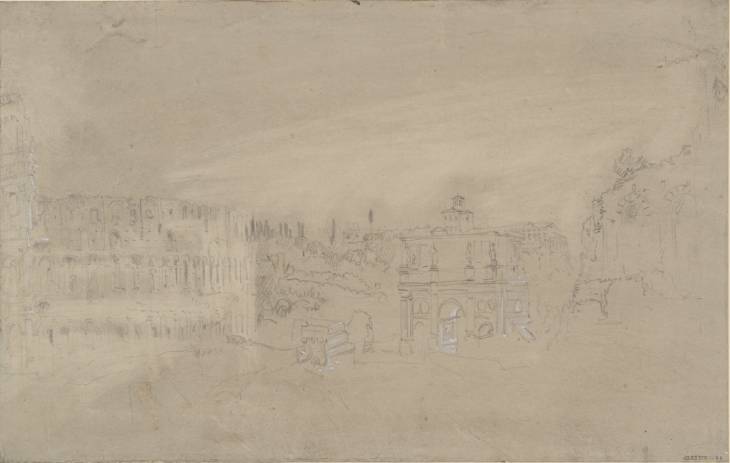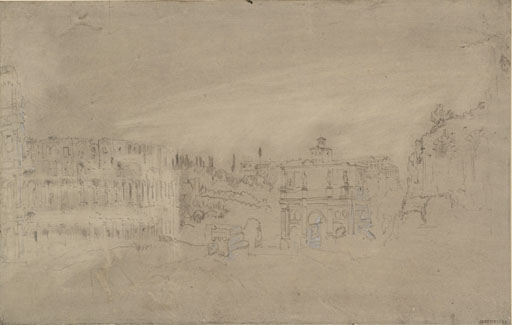Joseph Mallord William Turner The Colosseum and the Arch of Constantine, Rome, from the Temple of Venus and Roma 1819
Image 1 of 2
Joseph Mallord William Turner,
The Colosseum and the Arch of Constantine, Rome, from the Temple of Venus and Roma
1819
Joseph Mallord William Turner 1775–1851
The Colosseum and the Arch of Constantine, Rome, from the Temple of Venus and Roma 1819
D16354
Turner Bequest CLXXXIX 28
Turner Bequest CLXXXIX 28
White gouache, pencil and grey watercolour wash on white wove ‘Valleyfield’ paper, 235 x 368 mm
Stamped in black ‘CLXXXIX 28’ bottom right
Stamped in black ‘CLXXXIX 28’ bottom right
Accepted by the nation as part of the Turner Bequest 1856
Exhibition history
1904
National Gallery, London, various dates to at least 1904 (328).
References
1904
E.T. Cook and Alexander Wedderburn (eds.), Library Edition: The Works of John Ruskin: Volume XIII: Turner: The Harbours of England; Catalogues and Notes, London 1904, no.328, pp.378, 624, as ‘Rome: The Colosseum and Arch of Titus’.
1909
A.J. Finberg, A Complete Inventory of the Drawings of the Turner Bequest, London 1909, vol.I, p.563, as ‘The Colosseum and Arch of Titus. 328, N.G.’.
1920
D[ugald] S[utherland] MacColl, National Gallery, Millbank: Catalogue: Turner Collection, London 1920, p.88.
1984
Cecilia Powell, ‘Turner on Classic Ground: His Visits to Central and Southern Italy and Related Paintings and Drawings’, unpublished Ph.D thesis, Courtauld Institute of Art, University of London 1984, p.427, as ‘The Colosseum and Arch of Constantine’.
2008
Nicola Moorby, ‘Un tesoro italiano: i taccuini di Turner’, in James Hamilton, Nicola Moorby, Christopher Baker and others, Turner e l’Italia, exhibition catalogue, Palazzo dei Diamanti, Ferrara 2008, pp.102, 105 note 30.
2009
Nicola Moorby, ‘An Italian Treasury: Turner’s sketchbooks’, in James Hamilton, Nicola Moorby, Christopher Baker and others, Turner & Italy, exhibition catalogue, National Galleries of Scotland, Edinburgh 2009, pp.115, 155 note 31.
During his 1819 sojourn in Rome, Turner made numerous sketches in and around the Colosseum.1 This view depicts the western end of the famous amphitheatre from a point on the northern side of the Temple of Venus and Roma. Part of the ruined inner wall of the shrine dedicated to the goddess Venus is visible on the far right-hand side. Between the two ancient Roman structures is the Arch of Constantine and beyond that, the Church of Santi Giovanni e Paolo on the Caelian Hill. Turner also made a coloured study of the Colosseum from this same angle (see Tate D16364; Turner Bequest CLXXXIX 37).
Like many pages within this sketchbook the composition has been executed in pencil over a grey washed ground which acts as a mid-tone for dramatic constrasts in light and shadow. Turner has created pale highlights within the sky and the exterior of the Colosseum by lifting or rubbing through to the white paper beneath. Furthermore he has used touches of white gouache on the Arch of Constantine, on the edge of the northern outer wall of the Colosseum, and on a ruined block of masonry in the foreground. Darker areas have been described with heavy cross-hatched or shaded lines.
Further sketches juxtaposing the Arch of Constantine in relation to the Colosseum can be found in this sketchbook (see Tate D16355, D16389; Turner Bequest CLXXXIX 29, 58), as well as within the Albano, Nemi, Rome sketchbook (Tate D15397; Turner Bequest CLXXXII 53), the St Peter’s sketchbook (Tate D16197; Turner Bequest CLXXXVIII 2) and the Smaller Roman C. Studies sketchbook (Tate D16398, D16416, D16455; Turner Bequest CXC 4, 15a, 41).
Verso:
?Blank (pasted to mount).
Nicola Moorby
July 2009
How to cite
Nicola Moorby, ‘The Colosseum and the Arch of Constantine, Rome, from the Temple of Venus and Roma 1819 by Joseph Mallord William Turner’, catalogue entry, July 2009, in David Blayney Brown (ed.), J.M.W. Turner: Sketchbooks, Drawings and Watercolours, Tate Research Publication, December 2012, https://www


